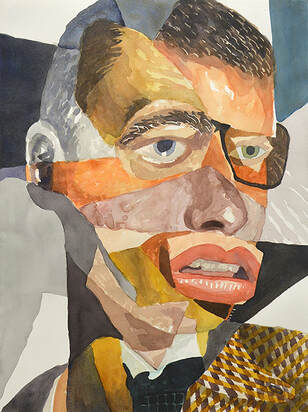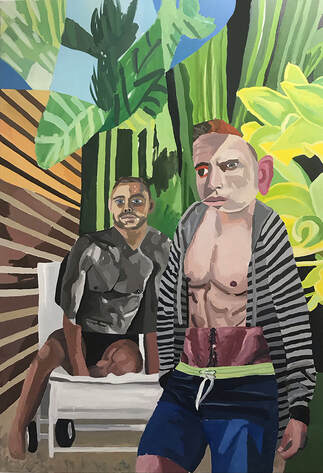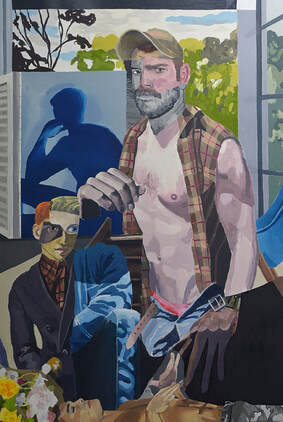|
Interview: Christopher George David Lock brings together a ‘monstrous’ but beautiful dialogue in the relationship of our human species. Often with an ambiguous narrative on the power play within couplings; David Lock has become a highly sought after artist, not only for his modern take on portraiture and figurative painting, but also for his interpretation on the classics of painting. SoEdited gained exclusive time to interview Lock before a season of exhibitions he has embarked on. SE: You use collage in your portrait works, creating a mix match of characters that almost have a schizophrenic personality- could you tell us why? D: For me the collage is a way of keeping things in flux. My work is about masculinity and I’m interested in how we as men demonstrate masculinity. It changes from moment to moment, and in that way I just want to keep different moments in play. SE: How do you work with collage and then bring this into your own painting format. And why is the collage system so interesting to you? D: It allows me to pose questions, so it’s open-ended in that way. I usually directly cut up magazines or I take images from the internet, I like the use of digital as its the world we now live in. In taking mass-media images and then mixing them into paintings, it changes the context and becomes about masculinity in relation to the history of painting. Of course there’s also a history with collage- for example Dada. But with painting you’re entering into a dialogue steeped in tradition, and that constant need to keep it urgent and engaging. SE: Sexuality is a strong part of your work. What is the mystique in sexuality that fascinates you when produce your paintings. D: It’s a tricky one. Sexuality fascinates me, it’s a powerful drive. I want to ask questions about the differences when it comes to desire. I don’t just want to recreate standard tropes of homoerotic desire, so i’m trying to find new ways to explore the homoerotic imaginary, and that’s not necessarily an easy thing to do. SE: We seem to have 2 spectrums of power in your works; money and youth. Can you talk to me from your perspective. D: My images are taken from mainstream magazines, so there’s a power structure inherent as a capital force. However I never think about capital/money in terms of my paintings content; of course that might be a by-product of the figures I choose to assemble. For a while with the Misfit paintings I just made portraits, but then I felt I should give them a context. I am interested in undermining and playing with the ‘ideal’ in terms of masculinities, and so the environments they are in can then become the desirable element. By breaking that up through collaging and frustrating its reading, I then reimagine it as a kind of ‘monstrous coupling’. There’s a resistance and you’re undermining that power structure. It’s the same with my more direct paintings. I’m interested in questioning society’s ideals of masculinities, that’s why I work from the mass-media images rather than from life models. The images I choose to make a painting from, they have to already be functioning as a desirable object in a magazine or whatever other portal of desire I use as a resource tool. SE: This sexual power spectrum is as old as currency itself, and never looses its grip on us humans. Why do you think this is such a powerful situation across all sexualities? D: From our perspective, we live in a western capitalist democracy. It’s about power and nothing sells like sex and desire. It’s based around lacking and constantly needing to be fulfilled. SE: With currency and sex being such a stable part of society, why do you think in the 21st century we still have such a difficult situation in accepting sex? D: I think our ideas of sexuality are still very rigid, and based on heteronormativity. I think the problem stems from conformity and control. Progressive society breaks down barriers, but if those hard fought for liberal values of full equality are not demanded and reinforced, our civil liberties will become eroded again. You can already see that happening in the USA, and already we have a lack of tolerance emerging in the UK. We now live in a culture where a divisive rhetoric is winning. Only recently, people thought the USA and the UK were reliable western democracies but now we are looking like a hopeless mess. When you see the censorship and homophobia increasing in Russia, whose to say that could not happen here. We are witnessing an increase in LGBT hate crime right now. Where will this end? SE: As a dancer with the Candoco Dance Company from 2001, how was this experience on a personal level, and how did this then feed into your paintings? D: It was great, I loved working with them. I’d danced since the 80’s as I was a breakdancer, so dance was always something close to my heart. It was great to be part of an ensemble, pushing each other in various creative ways, from our wonderful Artistic Director Celeste Dandeker OBE, through to the other dancers and the great choreographers we worked with. It was an honour to be a part of Candoco, and when I joined they had already established themselves as the leading dance company of disabled and non disabled dancers. We all really strove and pushed each other to produce the best work. After leaving Candoco I wanted to get that sense of movement into my paintings. I want the figures and their surroundings to be fluid and dynamic. SE: When you’re at your studio do you like to be isolated and work in silence. Or is the studio a social area where you listen to music. What sounds do you like to have in the studio to inspire your mood, or to just give you some background noise. Is your studio and work place a relaxed environment, or is it a place where you need to concentrate and be focused. D: It just depends what mood i’m in. I go into the studio and evaluate what i’ve done the day before with fresh eyes, it’s a focused atmosphere. Often it’s silence, just me and the painting. Other times it’s music and occasionally the radio. I’ll put Spotify on my phone or shuffle my iPod until I hear something come on I want to play more, Kate Bush say, or The Weekend. I get so absorbed in painting though that an album goes by in two minutes, I hardly notice it’s ended. I share my studio with my partner Stephen. He has a nice space at the back. He’s studying for an OU degree, so I also have to negotiate the space with him. SE: You’ve been in London for many years now. Is there somewhere else you would like to potentially spend more time? From your paintings we have an idea of blue sky, tropical plants, hot weather. Do you crave for what you create in your paintings? D: No, not at all, I quite like grey London, at least whilst holding out praying for Brexit not to happen. The tropical trees and blue skies were really just a couple of paintings I made when I was researching and fascinated by William Burroughs and Joe Orton in Tangiers. From that I made the paintings ‘Misfits (Garden)’ and ‘El Muniria’ which was in last years ‘John Moores Painting Prize’. I was thrilled about that, as it’s the UK’s most prestigious painting award. Then the Walker Art Gallery purchased the painting for their permanent collection! SE: Leicester. Grim, grey, depressing, un-accepting and certainly not cosmopolitan… Sorry if you find my observation offensive, but I am also from the area so find it completely acceptable to beat the place up! But what is your relationship to Leicester. And what did Leicester bring into your work? D: Haha, yes it’s funny those places form you as a person, that sense of not belonging, of being bored and wanting to escape. However growing up in the 80’s I found kindred spirits who also loved bands like The Pixies, My Bloody Valentine and Cocteau Twins. We’d go to clubs like the Fan Club and later Streetlife, Leicesters gay club. The Alternative scene, then afterwards trying to avoid getting beaten up by the townies in the taxi rank on the way home. It definitely wasn’t cosmopolitan! However, I made lasting lifelong friends growing up there, so it doesn’t matter where you are, you eventually find your tribe. That sense of not fitting in, that can be a positive thing, it definitely informed my work, it’s good to be awkward and let things go awry. SE: What music have you been listening to today, and why? D: I was listening to the amazing make-up artist Pat McGrath on Desert Island Discs. She was just fab. One of her choices was ‘La Vie En Rose’ by Grace Jones, so after that I put ‘Island Life’ on. I love that album and I used to listen to it a lot. I’ve also been listening to ‘Chris’, the new album by Christina and the Queens. I loved her first album, but with this new one, I really like how she’s playing with gender, and identifying as a man in a performative way, bringing that to a pop context, it’s brilliant. For Exhibition Updates: David Lock
2 Comments
|
sø•artyCreative minds produce in all mediums. Displaying some of the finest art items edited to suit a refined self and lifestyle Archives
April 2024
|








 RSS Feed
RSS Feed